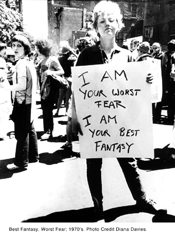 |
||||
| Still from No Secret Anymore: The Times of Del Martin and Phyllis Lyon (dir. Joan E. Biren, 2003). Used with permission from Diana Davies. | ||||
|
||||
Journal Issue 3.1
Spring 2011
Edited by Agatha Beins, Deanna Utroske, Julie Ann Salthouse, Jillian Hernandez, and
Karen Alexander
Editorial Assistants: Mimi Zander and A.J. Barks
Living with Pride: Ruth C. Ellis @ 100. Directed by Yvonne Welbon. Ho Ho Kus, NJ: Sisters in the Life, 2000.
No Secret Anymore: The Times of Del Martin & Phyllis Lyon. Directed by Joan E. Biren. San Francisco: Frameline, 2003.
Golden Threads. Directed by Lucy Winer and Karen Eaton. New York: Wildlight Productions, 1999.
continued
Reviewed by Julie R. Enszer
Filmmaker Joan E. Biren frames the experiences of lesbians during the 1950s and 1960s through interviews with Lyon and Martin as well as with other women.3 She enlivens these narratives with visuals from material artifacts about lesbians during this time including pulp novels, The Songs of Bilitis by Pierre Louÿs and The Ladder, which was the magazine of the Daughters of Bilitis. She also weaves in footage of U.S. historical milestones such as the McCarthy hearings and civil rights demonstrations and images of Harvey Milk.
Biren expertly uses interviews with other activists, who describe their experiences encountering the work of Martin and Lyon, not to invoke hagiography but to examine the impact of Lyon and Martin’s work on generations of activists. The effect is a fulfillment of Lyon’s wish near the end of the film; Lyon says, “I want to see other people get inspired the way we do. In every success there is another to turn on.”
No Secret Anymore explores Martin and Lyon as politically—and organizationally—savvy women and embeds their lives and experiences in a broader narration about lesbian and gay rights in the United States. This film would be effective in classes exploring lesbian, gay, bisexual, or transgender (LGBT) identities, twentieth-century history, political movements, and women’s studies.4
Golden Threads is a 56-minute documentary about Christine Burton and the organization she founded, Golden Threads, a correspondence club for mature and old lesbians. The film centers on the annual gathering of Golden Threads members in Provincetown, RI. During the first half of the film, interviews with Burton and members of Golden Threads provide engaging perspectives on growing older, dating, and the lives of older lesbians. Many of the women discuss coming out experiences during various decades of the twentieth century.
The real drama of the documentary, however, emerges halfway through the film. Immediately after Golden Threads’s gathering, Burton has a stroke. The second half of the film explores Burton’s life after the stroke. Here compelling footage of Burton’s rehabilitation process and her return to the Golden Threads tenth anniversary gathering a year later is combined with members of Golden Threads reflecting on being sick and living with disabilities. This part of the film is both challenging and riveting for viewers. Director Lucy Winer holds the camera lens on images of Burton’s body as well as the bodies of other older lesbians. She tells a story of aging that is neither idealizing nor mawkish and instead probes with respect and sincere interest the experiences of her subjects.
Golden Threads has at its center lesbianism, but the film is most powerfully an exploration of the effects of aging in women’s lives. When women in the film talk about growing older, their reflections are less about aging and sexual orientation and more about gender and aging. Intersections among disability, gender, and sexual orientation are made visible through the film.
Students may need additional information or contextualization when encountering Golden Threads in a classroom. For students without knowledge of the history and experiences of gay and lesbian people in the twentieth century, some of the narrative might be confusing, including references to Stonewall, experiences in mental institutions, and school teachers fearing arrest. Golden Threads provides a perspective on lesbians and aging that will intrigue students in a variety of disciplines—women’s studies, LGBT studies, gerontology, social work, and sociology.5
Julie R. Enszer (JulieREnszer@gmail.com) is a graduate student in the Women’s Studies Department at the University of Maryland. She is working on her dissertation on lesbian print culture from 1969 through 1989. Her first collection of poetry, Handmade Love, was published in 2010 by A Midsummer Night’s Press; her chapbook, Sisterhood, was published in 2010 by Seven Kitchens Press. She curates the Lesbian Poetry Archive at www.LesbianPoetryArchive.org and is a regular book reviewer for Lambda Literary and CALYX.
3 Director Joan E. Biren (JEB) is a documentary film artist known for her two documentaries on national lesbian and gay marches, For Love & For Life: The 1987 March on Washington for Lesbian and Gay Rights (1993) and A Simple Matter of Justice: The 1993 March on Washington for Lesbian, Gay and Bi Equal Rights and Liberation (1993). She also made the film Women Organize! (2000) about women involved in global struggles for racial, social, and economic justice. For a complete filmography, see: http://www.jebmedia.com/_wsn/page2.html.
4 Marcia M. Gallo’s excellent history of the Daughters of Bilitis, Different Daughters: A History of the Daughters of Bilitis and the Rise of the Lesbian Rights Movement (New York: Carroll & Graf, 2006) would be strong companion reading with No Secret Anymore.
5 Look Me in the Eye: Old Women, Aging, and Ageism by Barbara MacDonald and Cynthia Rich (San Francisco: Spinsters Ink, 2001) is an excellent text to read in conjunction with Golden Threads.
Copyright © 2014. All rights reserved.